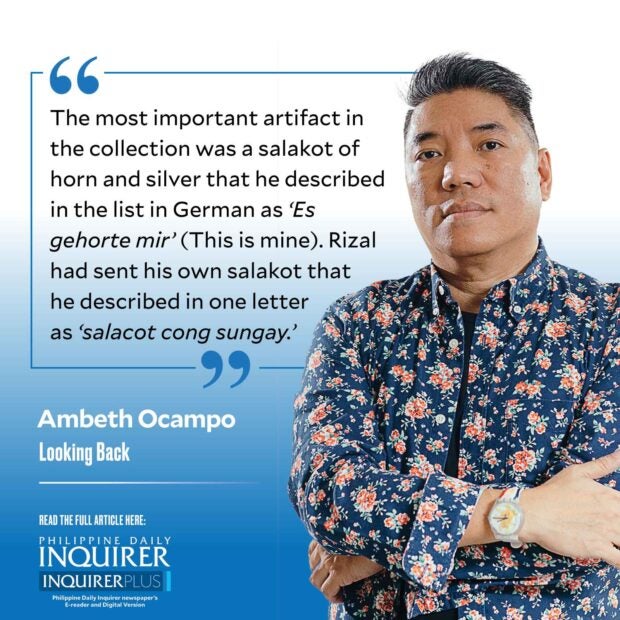Rizal’s hat in Berlin
After a special screening of the 1998 movie biography “Jose Rizal,” I hurried out of the theater as soon as the final credits started rolling to avoid being asked what the film got right or wrong. The late Marilou Diaz-Abaya caught me by the door and gave me a research tip, “look up the Rizal collection in Berlin.” I knew that Rizal sent natural science specimens to Dresden, not Berlin. From the many materials he sent from Dapitan, his place of exile, three brought Rizal’s name into taxonomy: Draco rizali (a winged-lizard), Rhacophorus rizali (a frog), and Apogonia rizali (a bug). Diaz-Abaya reported seeing clothing rather than reptiles, fish, butterflies, and ethnographic objects. She was particularly impressed by a lowland Christian woman’s ensemble, and described it in great detail: a jusi blouse with silk stripes, a pañuelo or large scarf of nipis, a veil, a dark silk tapis. Everything was of high quality and workmanship seldom seen today. Then, with a knowing smile, she concluded that the choice of textiles and articles of clothing was of such good taste, “these could not have been chosen by a straight man.” She left me at that and challenged me to do further research. I brushed away the gay or metrosexual angle to the question with the knowledge that the clothing in Berlin was probably sourced and chosen by Rizal’s mother or any of his nine sisters. Saturnina, the eldest, had a jewelry business, while the two younger spinster sisters Trinidad and Josefa, operated a textile store in prewar Manila.
Over a decade after Diaz-Abaya gave me this research tip, the Goethe-Institut Manila gave me a grant to physically check out the Berlin collection. It was then that I realized that this collection eluded researchers for a long time, because of the more documented collection of natural history specimens and a handful of ethnographic items in the Dresden museum. Rizal sent these through Dr. Adolf Bernhard Meyer, who Rizal met in 1886. They remained in correspondence while Rizal was in Europe, and also while he was in exile in Dapitan from 1892-1896. Most of the Rizal collection in Dresden awaits further research; these include: four wood spoons with human figures from the Cordilleras, a barong or cutlass with its wood sheath, and a brass betel nut presentation tray from Mindanao. These were sent to Meyer in exchange for books that provided company and consolation to the hero in far-off Dapitan.
To my surprise not only did the Berlin Ethnological Museum have a Rizal collection, it came with a previously unpublished letter, dated July 3, 1888, to Adolf Bastian that listed the 22 items he sent from London, 15 were articles of clothing, 13 were textile samples that included piña or pineapple fiber. On the packing list, he left short remarks on the use and origin of each:
One camisa de piña para hombre (pineapple-fiber man’s shirt), one velo de mujer (Lambong) (woman’s veil), one pañuelo de nipis (woman’s scarf made of nipis* that originally referred to fine abaca but later became a generic term for any thin cloth of different material: piña, banana fiber, and other light, translucent fabric), one camisa de jusi for women (women’s jusi shirt), one saya for women, one patadion[g] (wide skirt, Mindanao), one bakus o cordon de mujer (beadwork cord for women, Mindanao), one camisa de mujer (Baumrinde) (women’s bark cloth shirt, Mindanao), one banda para llevar al niño (cloth band for carrying an infant, Mindanao), one cinturon (belt, Mindanao), one camisa de hombre (men’s shirt, Mindanao), one calzon (breeches, Mindanao), one camisa (shirt, Mindanao), one pañuelo (scarf), and one tapis de seda de los Tagalos (Tagalog silk skirt).
What is fascinating are the textiles from Mindanao. How were these sourced, gathered in Manila, and sent to Europe? Special mention should be made of a rare Bagobo ensemble. But for me, the most important artifact in the collection was a salakot of horn and silver that he described in the list in German as “Es gehorte mir” (This is mine). Rizal had sent his own salakot that he described in one letter as “salacot cong sungay.” I was tempted to try it on, but was afraid the curators would throw me out. These items preserved in a museum bodega in Berlin prove that there is much more to Rizal that lies in wait to be rediscovered and add to our existing knowledge of the National Hero.
—————-
Comments are welcome at [email protected]
Disclaimer: The comments uploaded on this site do not necessarily represent or reflect the views of management and owner of Cebudailynews. We reserve the right to exclude comments that we deem to be inconsistent with our editorial standards.

